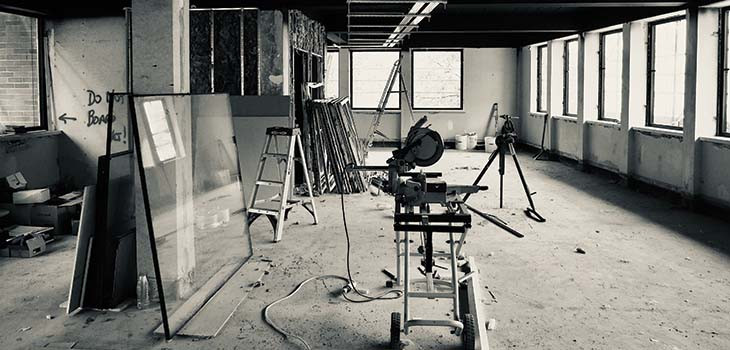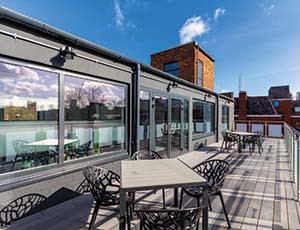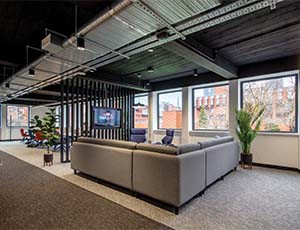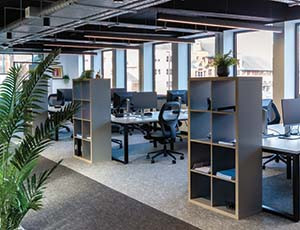*/

In recent years, COVID, new ways of working, and rising costs have compounded the already vexed question of chambers’ premises. At Parklane Plowden, after debating the ‘move or refurb’ question for some time, we decided to go down the refurbishment route. We completed our significant remodelling project in February 2022 and this has transformed the way our Leeds premises looks and is used.
Having recently moved back in, we (the Property Committee who managed the project) wanted to share some thoughts based on our experience.
There are likely to be a range of views about the best way forward and it will be impossible to give everyone exactly what they want. We were anxious to ensure that any chosen proposal had the overwhelming support of members. To achieve that consensus, we focused on two main things:
While we were tempted to try to do everything ourselves, we realised early on that there was just too much to do, and expert input would be essential.
On the build side, we interviewed and selected an interior designer, quantity surveyor and project manager.
On the finance side, we were fortunate to have a finance team within Chambers. With their help, we were able to fund the project through a mixture of savings, loans, rebates and cost savings. Crucially, this meant that we didn’t have to ask members to contribute over and above their usual calls.
Refurbishment projects come in all shapes and sizes, and what you choose to build will depend on your size, working practices, existing premises and budget. These are our main takeaways.
The transition from own office/desk to open plan/agile may sound daunting to some. Having made the change, we can confidently say it doesn’t need to be. In ‘the study’ (pictured top right), we have replicated the ‘own office’ feel whereas in ‘the lounge’ we have maximised the benefits of open plan. The study is silent, with traditional style desks and a no-calls or conversations rule. The lounge has various informal working areas, including a long table, alongside some traditional desks, sofas and a kitchen/dining area. We separated the main workspaces using acoustic fins, plants and furniture. We’ve found the lounge to be the most popular area, and the idea of solo occupancy offices now feels somewhat antiquated. Members were also prepared for the transition by having an agile temporary office while the building was closed for the refurb.
Paperless working and remote/hybrid hearings and conferences are here to stay. To persuade members to leave the comfort of their own homes, a building needs to have the best technology practicable. We could probably have gone further (and eventually will) but for now we’ve got desk-mounted power throughout, plug and play monitors for second-screening, wireless phone charging, conference rooms with wall mounted video conferencing facilities, telephone booths and what we call ‘case rooms’ – for remote work which include HD monitors, HD webcams, and condenser microphones.
We almost made the mistake of opting for a compromise solution, which ultimately would have been a glorified facelift. As it happened, the pandemic forced us to reconsider, and we chose a much more radical solution which members have fully embraced. Also, if like us you’re lucky enough to have a redundant flat roof, you can seek to persuade the undecided by promise of a south-facing roof terrace!
Retro fitting a ‘COVID-safe’ solution to an old office is likely to be difficult. If you’re starting afresh with a full refurbishment project, control measures can be incorporated into the design. For example, we’ve moved from cramped offices towards larger and less populated open spaces, created better traffic routes around the building and added mechanical fresh air ventilation.
A full refurbishment project is also a great opportunity to incorporate changes that improve how accessible your building is for your clients, members and staff. This was an important part of our thinking behind the larger open plan area. We also chose to widen walkways, install a larger lift, and add several accessible WCs.
If you are considering a chambers refurbishment and would like to discuss any aspect of running a project such as this, please don’t hesitate to get in touch.




In recent years, COVID, new ways of working, and rising costs have compounded the already vexed question of chambers’ premises. At Parklane Plowden, after debating the ‘move or refurb’ question for some time, we decided to go down the refurbishment route. We completed our significant remodelling project in February 2022 and this has transformed the way our Leeds premises looks and is used.
Having recently moved back in, we (the Property Committee who managed the project) wanted to share some thoughts based on our experience.
There are likely to be a range of views about the best way forward and it will be impossible to give everyone exactly what they want. We were anxious to ensure that any chosen proposal had the overwhelming support of members. To achieve that consensus, we focused on two main things:
While we were tempted to try to do everything ourselves, we realised early on that there was just too much to do, and expert input would be essential.
On the build side, we interviewed and selected an interior designer, quantity surveyor and project manager.
On the finance side, we were fortunate to have a finance team within Chambers. With their help, we were able to fund the project through a mixture of savings, loans, rebates and cost savings. Crucially, this meant that we didn’t have to ask members to contribute over and above their usual calls.
Refurbishment projects come in all shapes and sizes, and what you choose to build will depend on your size, working practices, existing premises and budget. These are our main takeaways.
The transition from own office/desk to open plan/agile may sound daunting to some. Having made the change, we can confidently say it doesn’t need to be. In ‘the study’ (pictured top right), we have replicated the ‘own office’ feel whereas in ‘the lounge’ we have maximised the benefits of open plan. The study is silent, with traditional style desks and a no-calls or conversations rule. The lounge has various informal working areas, including a long table, alongside some traditional desks, sofas and a kitchen/dining area. We separated the main workspaces using acoustic fins, plants and furniture. We’ve found the lounge to be the most popular area, and the idea of solo occupancy offices now feels somewhat antiquated. Members were also prepared for the transition by having an agile temporary office while the building was closed for the refurb.
Paperless working and remote/hybrid hearings and conferences are here to stay. To persuade members to leave the comfort of their own homes, a building needs to have the best technology practicable. We could probably have gone further (and eventually will) but for now we’ve got desk-mounted power throughout, plug and play monitors for second-screening, wireless phone charging, conference rooms with wall mounted video conferencing facilities, telephone booths and what we call ‘case rooms’ – for remote work which include HD monitors, HD webcams, and condenser microphones.
We almost made the mistake of opting for a compromise solution, which ultimately would have been a glorified facelift. As it happened, the pandemic forced us to reconsider, and we chose a much more radical solution which members have fully embraced. Also, if like us you’re lucky enough to have a redundant flat roof, you can seek to persuade the undecided by promise of a south-facing roof terrace!
Retro fitting a ‘COVID-safe’ solution to an old office is likely to be difficult. If you’re starting afresh with a full refurbishment project, control measures can be incorporated into the design. For example, we’ve moved from cramped offices towards larger and less populated open spaces, created better traffic routes around the building and added mechanical fresh air ventilation.
A full refurbishment project is also a great opportunity to incorporate changes that improve how accessible your building is for your clients, members and staff. This was an important part of our thinking behind the larger open plan area. We also chose to widen walkways, install a larger lift, and add several accessible WCs.
If you are considering a chambers refurbishment and would like to discuss any aspect of running a project such as this, please don’t hesitate to get in touch.





Chair of the Bar reflects on 2025
Q&A with criminal barrister Nick Murphy, who moved to New Park Court Chambers on the North Eastern Circuit in search of a better work-life balance
Revolt Cycling in Holborn, London’s first sustainable fitness studio, invites barristers to join the revolution – turning pedal power into clean energy
Rachel Davenport, Co-founder and Director at AlphaBiolabs, reflects on how the company’s Giving Back ethos continues to make a difference to communities across the UK
By Marie Law, Director of Toxicology at AlphaBiolabs
AlphaBiolabs has made a £500 donation to Sean’s Place, a men’s mental health charity based in Sefton, as part of its ongoing Giving Back initiative
Professor Dominic Regan and Seán Jones KC present their best buys for this holiday season
Little has changed since Burns v Burns . Cohabiting couples deserve better than to be left on the blasted heath with the existing witch’s brew for another four decades, argues Christopher Stirling
Six months of court observation at the Old Bailey: APPEAL’s Dr Nisha Waller and Tehreem Sultan report their findings on prosecution practices under joint enterprise
Despite its prevalence, autism spectrum disorder remains poorly understood in the criminal justice system. Does Alex Henry’s joint enterprise conviction expose the need to audit prisons? asks Dr Felicity Gerry KC
With automation now deeply embedded in the Department for Work Pensions, Alexander McColl and Alexa Thompson review what we know, what we don’t and avenues for legal challenge